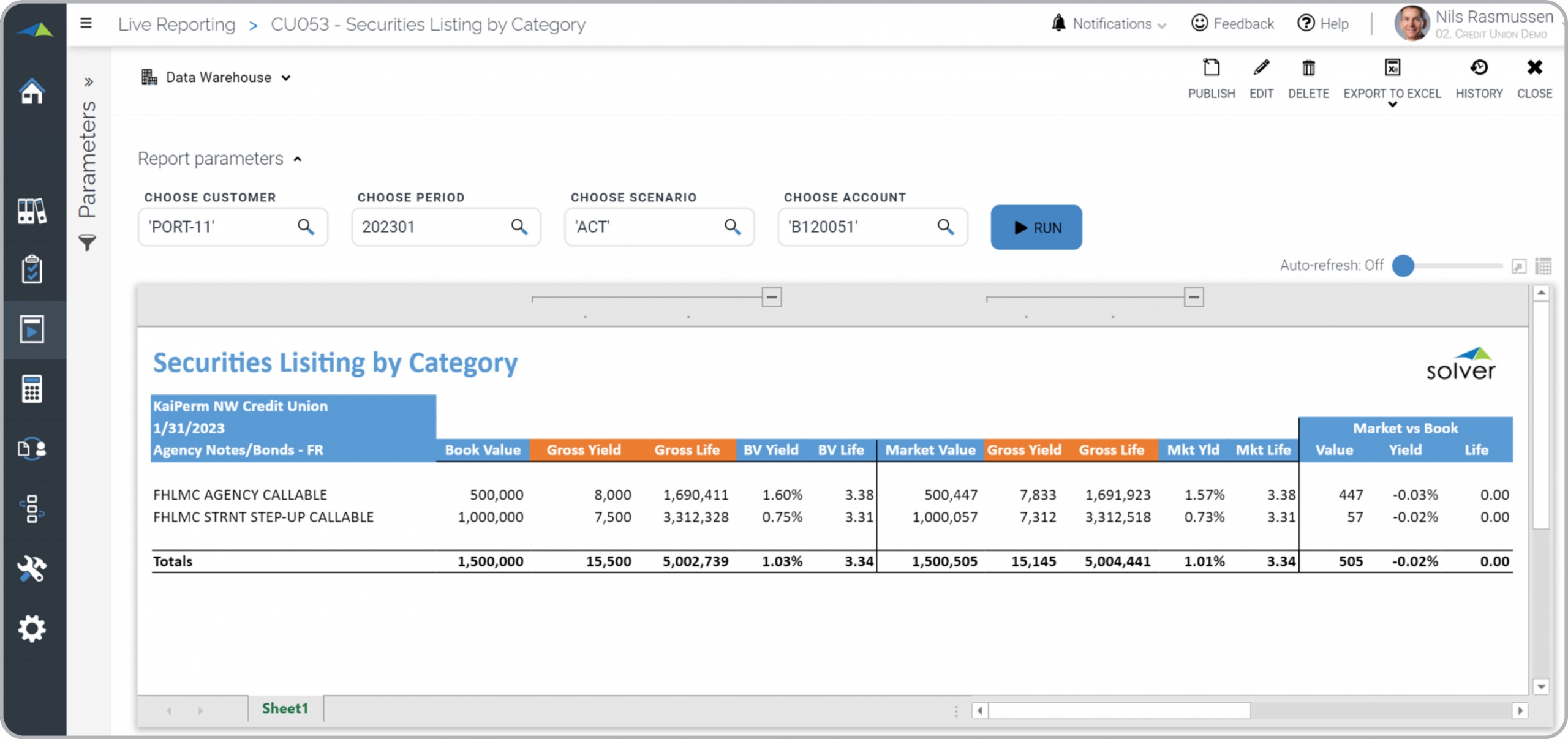Securities by Category Report for Credit Unions
What is
a
Securities by Category Report
? Securities Reports are considered portfolio analysis tools and are used by investment managers and analysts to analyze market- and book values of different security categories. Some of the main functionality in this type of report is that it is parameter driven and for any select group of securities it displays book- and market values as well as variances between these. The security categories are listed in the rows. Across the columns you find: Book value and its yield and life metrics, market value with yield and life metrics, and variances between book and life metrics. You find an example of this type of report below.
Purpose of
Securities by Category Reports Credit Unions use Securities by Category Reports to analyze book- and market value KPIs and variances. When used as part of good business practices in Investment- and Finance departments, a company can improve its securities strategies and profitability, and it can reduce the chances that a lack of easy on-demand reports reduces the ability to make faster and better decisions.
Example of a
Securities by Category Report Here is an example of a Securities by Category Report with value and yield metrics and variances as well as actual to budget comparisons. [caption id="" align="alignnone" width="2560"]
 Example of a Securities by Category Report for Credit Unions[/caption] You can find hundreds of additional examples
here
Who Uses This Type of
Report
? The typical users of this type of report are: Investment managers, securities portfolio managers, analysts.
Other Reports Often Used in Conjunction with
Securities by Category Reports Progressive Investment- and Finance departments sometimes use several different Securities by Category Reports, along with securities transaction reports, investment dashboards, KPI dashboards, securities dashboards and other management and control tools.
Where Does the Data for Analysis Originate From? The Actual (historical transactions) data typically comes from portfolio management software and enterprise resource planning (ERP) systems like: Microsoft Dynamics 365 (D365) Finance, Microsoft Dynamics 365 Business Central (D365 BC), Microsoft Dynamics AX, Microsoft Dynamics NAV, Microsoft Dynamics GP, Microsoft Dynamics SL, Sage Intacct, Sage 100, Sage 300, Sage 500, Sage X3, SAP Business One, SAP ByDesign, Acumatica, Netsuite and others. In analyses where budgets or forecasts are used, the planning data most often originates from in-house Excel spreadsheet models or from professional corporate performance management (CPM/EPM) solutions.
What Tools are Typically used for Reporting, Planning and Dashboards? Examples of business software used with the data and ERPs mentioned above are:
Example of a Securities by Category Report for Credit Unions[/caption] You can find hundreds of additional examples
here
Who Uses This Type of
Report
? The typical users of this type of report are: Investment managers, securities portfolio managers, analysts.
Other Reports Often Used in Conjunction with
Securities by Category Reports Progressive Investment- and Finance departments sometimes use several different Securities by Category Reports, along with securities transaction reports, investment dashboards, KPI dashboards, securities dashboards and other management and control tools.
Where Does the Data for Analysis Originate From? The Actual (historical transactions) data typically comes from portfolio management software and enterprise resource planning (ERP) systems like: Microsoft Dynamics 365 (D365) Finance, Microsoft Dynamics 365 Business Central (D365 BC), Microsoft Dynamics AX, Microsoft Dynamics NAV, Microsoft Dynamics GP, Microsoft Dynamics SL, Sage Intacct, Sage 100, Sage 300, Sage 500, Sage X3, SAP Business One, SAP ByDesign, Acumatica, Netsuite and others. In analyses where budgets or forecasts are used, the planning data most often originates from in-house Excel spreadsheet models or from professional corporate performance management (CPM/EPM) solutions.
What Tools are Typically used for Reporting, Planning and Dashboards? Examples of business software used with the data and ERPs mentioned above are:
- Native ERP report writers and query tools
- Spreadsheets (for example Microsoft Excel)
- Corporate Performance Management (CPM) tools (for example Solver)
- Dashboards (for example Microsoft Power BI and Tableau)
Corporate Performance Management (CPM) Cloud Solutions and More Examples
August 26, 2021
TAGS:
Reporting,
Solver,
report writer,
Microsoft,
gross yield,
template,
practice,
Acumatica,
Netsuite,
Finance,
credit union,
planning,
GP,
fintech,
life value,
Business Central,
excel,
gross life,
ax,
market value,
securities,
forecast,
Budget,
Dynamics 365,
budgeting,
bank,
Cloud,
Software,
Tableau,
SAP,
example,
best,
book value,
Sage,
BC,
D365,
NAV,
Intacct,
financial institution,
CPM,
report,
branch,
SL,
Management,
dynamics,
Power BI,
securities by category

